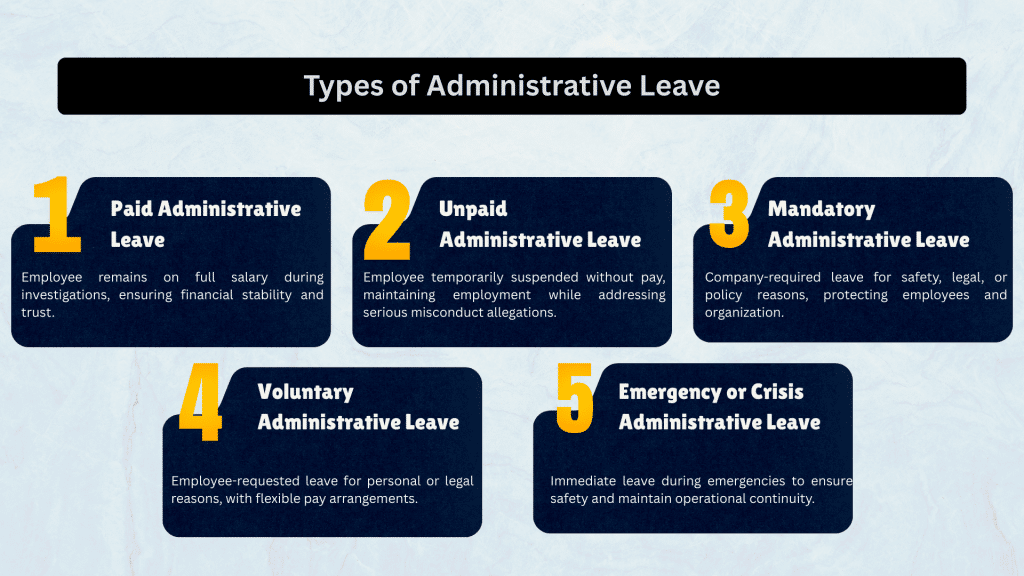Administrative leave is a temporary absence from work that employers grant while investigating workplace issues or managing sensitive situations.
Understanding this employment practice becomes essential in today’s professional environment.
Many workers feel confused when placed on such leave, unsure about their rights and what happens next.
This comprehensive blog explains the concept in simple terms.
You’ll learn about different types, when they apply, and how they differ from other absence options.
What is Administrative Leave?
It refers to a temporary work suspension where an employer removes a worker from their duties while maintaining their employment status.
Unlike termination, this arrangement keeps the working relationship intact during evaluation periods.
Organizations typically use this tool when serious allegations arise or investigations are required.
Common situations triggering this action include:
- Misconduct allegations requiring investigation
- Organizational restructuring periods
- Safety concerns requiring immediate separation
During this status, workers typically:
- Cannot access workplace facilities without permission
- Must avoid contact with colleagues or clients
- Retain access to benefits and support services
Types of Administrative Leave

Organizations offer several forms of administrative leave, each with distinct characteristics and applications.
All types serve organizational needs while maintaining fairness during sensitive periods.
1. Paid Administrative Leave
Paid administrative leave allows employees to receive their regular salary while away from work duties.
This demonstrates good faith on the part of management and helps maintain financial stability during investigations.
Common Use Cases:
- Allegations lack substantial evidence
- Investigations may take considerable time
- Minor infractions requiring external review
Benefits:
- Maintains staff morale and trust
- Reduces legal challenges over lost wages
- Continued health insurance coverage
Public sector jobs often automatically provide paid status during investigations.
2. Unpaid Administrative Leave
Unpaid administrative leave suspends salary while keeping the employment relationship intact.
It’s typically used for allegations of serious misconduct.
Common Use Cases:
- Theft or embezzlement
- Workplace violence incidents
- Serious policy violations
Challenges:
- Financial pressure on employees
- Need for alternative income
- Increased stress during investigations
Despite the lack of pay, the employee’s position remains protected.
3. Mandatory Administrative Leave
This leave is required by company policy for certain incidents, regardless of evidence or investigation status.
Common Use Cases:
- Exposure to health or safety risks
- Legal obligations requiring temporary removal from duties
Benefits:
- Protects both the employee and the organization
- Reduces liability and risk of further incidents
4. Voluntary Administrative Leave
Employees may request this leave when they need time away from work for personal or legal reasons, typically with or without pay, depending on the policy.
Common Use Cases:
- Personal matters affecting work performance
- Voluntary removal during ongoing investigations to reduce stress
Benefits:
- Provides flexibility and support to employees
- Minimizes disruption to workplace operations
5. Emergency or Crisis Administrative Leave
Granted, during immediate crises such as workplace accidents, natural disasters, or security threats.
Common Use Cases:
- Workplace emergencies
- Threats to employee safety
Benefits:
- Ensures safety and well-being
- Maintains business continuity during unexpected events
The Purpose of Administrative Leave
This workplace tool supports management by enabling thorough investigations while protecting all parties.
It ensures fairness, prevents interference, and safeguards employment rights.
Key Benefits:
- Promotes fairness during sensitive situations
- Protects employees and management from bias or harm
- Reduces legal risks and maintains operational stability
- Minimizes workplace disruption and hostile environments
Employee Rights and Obligations During Administrative Leave
Being placed on administrative leave can be overwhelming, but understanding your rights and responsibilities helps you navigate this challenging period more effectively.
Understanding these elements ensures you receive fair treatment while maintaining professional standards throughout the investigation process.
Both employees and employers benefit when everyone understands the boundaries and expectations during this temporary work suspension.
Employee Rights
- Fair Treatment: Leave cannot be used as punishment before the investigation
- Legal Representation: Consult an attorney or union representative if needed.
- Access to Information: Know the general nature of allegations and expected timelines.
- Benefits Continuation: Paid leave maintains benefits; unpaid leave may vary.
- Privacy: Personal and investigation details remain confidential.
- Right to Appeal: Disagree with decisions? Appeal through HR or mediation.
Employee Obligations
- Cooperate with the Investigation: Provide honest responses, documentation, and attend interviews.
- Maintain Confidentiality: Discuss details only with authorized personnel or legal counsel.
- Avoid Workplace Contact: Stay away from colleagues, clients, and systems unless authorized.
- Follow Restrictions: Comply with any conditions or limitations imposed by your employer.
What Should You Do When You Are on Administrative Leave?
Finding yourself on administrative leave can create uncertainty and stress, but taking the right steps helps protect your interests and career.
Proper preparation and professional behavior during this period significantly impact the outcome of the investigation and your future employment prospects.
Following these guidelines ensures you handle the situation appropriately while maintaining your professional reputation throughout the process.
1. Review Your Employment Documentation
Start by thoroughly reviewing your employee handbook, contract, and any union agreements to understand your company’s administrative leave policies.
Keep copies of all relevant documents in a secure location outside your workplace for future reference.
2. Consult with Legal or Union Representatives
Contact an employment attorney or union representative as soon as possible to understand your legal rights and options.
Many attorneys offer free consultations for employment matters, making legal guidance accessible even during financial uncertainty.
3. Maintain Professional Communication
Respond promptly and professionally to all communications from HR, management, or investigators throughout the leave period.
When communicating with authorized personnel, remain honest, factual, and cooperative, and follow any guidance from your legal counsel.
4. Organize Your Defense and Documentation
Gather all relevant documents, emails, and evidence that support your position regarding the allegations or situation.
Keep all documentation organized and easily accessible for meetings with investigators or legal representatives.
5. Take Care of Your Well-being
Administrative leave can create significant stress, so prioritize your physical and mental health during this challenging period.
Avoid making major life decisions or taking drastic actions while dealing with the emotional impact of workplace investigations.
6. Plan for Different Outcomes
Prepare for various investigation results, including reinstatement, disciplinary action, or potential termination from your position.
Review your financial situation and create a budget that accounts for potential changes in income during extended leave periods.
7. Stay Productive and Professional
Use the time away from work constructively by pursuing professional development, training, or skill-building activities.
Keep yourself mentally engaged and professionally active to demonstrate your commitment to your career and personal growth.
Key Differences Between Administrative and Other Leaves
This workplace suspension differs significantly from other types of absence in its initiation, purpose, and management.
| Type of Leave | Initiation | Purpose | Management |
|---|---|---|---|
| Sick Time | Worker-requested | Addresses health-related absences | Focused on recovery |
| Workplace Suspension | Management-initiated | Investigation and issue resolution | Centers on workplace concerns |
| Vacation Time | Worker-scheduled in advance | Planned rest and recreation | Personal time for leisure and family |
| Personal Time | Worker-requested | Addresses personal needs | Family emergencies, education, etc. |
| Administrative Leave | Management-initiated | Investigative purpose | Serves organizational needs during sensitive period |
What Happens During Administrative Leave?
Staff on this status typically wait for investigation outcomes while staying away from workplace activities.
They cannot influence ongoing investigations or access company resources without specific permission.
1. What to Expect During This Period?
- Regular updates about the investigation progress
- Expected timeline for communications from HR
- Required participation in interviews or meetings
2. Potential Impacts on Benefits
- Paid versions maintain full benefit coverage
- Unpaid arrangements may suspend certain benefits
- Health insurance continuation varies by policy
3. Possible Outcomes
- Favorable results leading to work resumption
- Full rights restoration upon return
- Disciplinary action based on findings
Clear organizational policies help workers understand potential consequences and their rights throughout the process.
Tips to Avoid Being Placed on Administrative Leave
Understanding what is administrative leave helps workers take preventive steps to avoid this situation.
Following these key practices reduces investigation risks:
- Follow all company policies and procedures consistently
- Maintain professional behavior with colleagues and clients
- Document important work communications properly
- Stay updated on policy changes and attend required training
Conclusion
This workplace tool offers a fair approach to handling investigations, striking a balance between employee rights and organizational needs.
The differences between paid and unpaid administrative leave depend on the situation of the allegations and the company’s resources.
It ensures continued employment status while allowing for a comprehensive review of issues.
This understanding fosters fairness in the workplace during challenging times.
Share your thoughts with us !
Frequently Asked Questions
Does Administrative Leave Appear on Background Checks?
Administrative leave typically doesn’t appear on standard background checks, as it’s an internal personnel matter.
Can Employees Take Another Job While on Administrative Leave?
Most employment contracts restrict outside work during administrative leave to prevent conflicts of interest.
Will Administrative Leave Impact Future Job Applications or References?
If investigations end favorably, administrative leave won’t affect future job prospects or references, as employers can’t share investigation details without authorization.
Are Family Dependents Impacted by Administrative Leave?
Family members are usually not directly impacted, though benefit changes may affect dependent coverage, and employee assistance programs often remain available and support.










